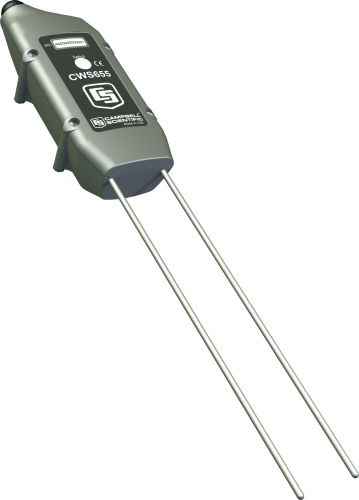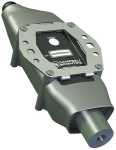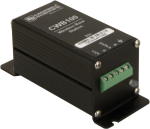This product is not available for new orders.

| Services Available |
|---|
Überblick
Der CWS655E ist eine kabellose Variante unseres CS655 Bodenfeuchtesensors. Er bestimmt volumetrischen Wassergehalt, elektrische Leitfähigkeit des Bodens und Bodentemperatur. der Sensor hat ein internes 868 MHz Funkmodem, dass die Daten an eine CWB100-Basis oder einen anderen kabellosen Sensor überträgt. Die 868 MHz-Frequenz wird in Europa vielfach verwendet.
Lesen Sie mehrFunktionen und Vorteile
- Vielseitiger Sensor, misst elektrische Leitfähigkeit, volumetrischen Wassergehalt, Dielektrizitätskonstante und Temperatur
- Messwerte werden korrigiert zur Vermeidung von Effekten durch verschiedene Bodenarten und elektrische Leitfähigkeiten
- Breitbandfunkmodem mit internen Frequenzsprüngen ermöglicht Übertragung über größere Strecken und mit weniger Inteferenzen
- Eine zuverlässige, wartungsarme und stromsparende Methode zum Messen wo Sensorkabel unpraktisch sind oder aus anderem Grund unerwünscht
- Übertagungen können von bis zu 3 anderen kabellosen Sensoren weitergegeben werden
- Battery powered
- Kompatibel mit CR300, CR800, CR850, CR1000, CR6 und CR3000 Datenlogger
Bilder

Technische Beschreibung
The CWS655E has 12-cm rods that insert into the soil. It measures propagation time, signal attenuation, and temperature. Dielectric permittivity, volumetric water content, and bulk electrical conductivity are then derived from these raw values.
Measured signal attenuation is used to correct for the loss effect on reflection detection and thus propagation time measurement. This allows accurate water content measurements in soils with bulk ≤3.7 dS m-1 without performing a soil-specific calibration.
Soil bulk electrical conductivity is also derived from the attenuation measurement. A thermistor in thermal contact with a probe rod near the epoxy surface measures temperature. Horizontal installation of the sensor provides accurate soil temperature measurement at the same depth as the water content measurement. For other orientations, the temperature measurement will be that of the region near the rod entrance into the epoxy body.
Why Wireless?
There are situations when it is desirable to make measurements in locations where the use of cabled sensors is problematic. Protecting cables by running them through conduit or burying them in trenches is time consuming, labor intensive, and sometimes not possible. Local fire codes may preclude the use of certain types of sensor cabling inside of buildings. In some applications measurements need to be made at distances where long cables decrease the quality of the measurement or are too expensive. There are also times when it is important to increase the number of measurements being made but the datalogger does not have enough available channels left for attaching additional sensor cables.
Kompatibel mit
Please note: The following shows notable compatibility information. It is not a comprehensive list of all compatible products.
Spezifikationen
| Weather Resistance | IP67 rating for sensor and battery pack (Battery pack must be properly installed. Each sensor is leak tested.) |
| Operating Temperature Range | -25° to +50°C |
| Operating Relative Humidity | 0 to 100% |
| Power Source | 2 AA batteries with a battery life of 1 year assuming sensor samples taken every 10 minutes. (Optional solar charging available.) |
| Average Current Drain | 300 μA (with 15-minute polling) |
| Rod Length | 12 cm (4.7 in.) |
| Body Dimensions | 14.5 x 6 x 4.5 cm (5.7 x 2.4 x 1.77 in.) |
| Weight | 216 g (7.6 oz) |
Measurement Accuracies |
|
| Volumetric Water Content | ±3% VWC typical in mineral soils that have solution electrical conductivity ≤10 dS/m. Uses Topps Equation (m3/m3). |
| Relative Dielectric Permittivity |
|
| Bulk Electrical Conductivity | ±(5% of reading + 0.05 dS/m) |
| Soil Temperature | ±0.5°C (for probe body buried in soil) |
Internal 25 mW FHSS Radio |
|
| Frequency | 868 MHz |
| Where Used | Europe |
| FHSS Channel | 16 |
| Transmitter Power Output | 25 mW (+14 dBm) |
| Receiver Sensitivity | -110 dBm (0.1% frame error rate) |
| Standby Typical Current Drain | 3 μA |
| Receive Typical Current Drain | 18 mA (full run) |
| Transmit Typical Current Drain | 45 mA |
| Average Operating Current | 15 μA (with 1-second access time) |
| Quality of Service Management | RSSI |
| Additional Features | GFSK modulation, data interleaving, forward error correction, BCH (31,21), data scrambling |
Dokumente
Broschüren Produkte
Verschiedenes
Videos & Tutorials
Downloads
Wireless Sensor Planner v.1.7 (30.5 MB) 08-08-2013
The Wireless Sensor Planner is a tool for use with Campbell Scientific wireless sensors. It assists in designing and configuring wireless sensor networks.
FAQs für
Number of FAQs related to CWS655E: 32
Alle anzeigenWenige anzeigen
-
The equation used to determine volumetric water content in the firmware for the CWS655 is the Topp et al. (1980) equation, which works for a wide range of mineral soils but not necessarily for artificial soils that typically have high organic matter content and high clay content. In this type of soil, the standard equations in the firmware will overestimate water content.
When using a CWS655 in artificial soil, it is best to perform a soil-specific calibration. For details on performing a soil-specific calibration, refer to “The Water Content Reflectometer Method for Measuring Volumetric Water Content” section in the CS650/CS655 manual. A linear or quadratic equation that relates period average to volumetric water content will work well.
-
No. The abrupt permittivity change at the interface of air and saturated soil causes a different period average response than would occur with the more gradual permittivity change found when the sensor rods are completely inserted in the soil.
For example, if a CWS655 was inserted halfway into a saturated soil with a volumetric water content of 0.4, the probe would provide a different period average and permittivity reading than if the probe was fully inserted into the same soil when it had a volumetric water content of 0.2.
-
No. The temperature sensor is located inside the sensor’s epoxy head next to one of the sensor rods. The stainless-steel rods are not thermally conductive, so the reported soil temperature reading is actually the temperature of the sensor head near the soil surface.
Because the sensor is installed vertically with the sensor head above ground, the soil temperature reading is not representative of the temperature over the length of the 12 cm rods, but the reading is closer to the temperature of the soil surface. Because the temperature reading is not representative of the entire thickness of soil measured for water content, no attempt was made to correct the water content readings for temperature changes.
-
The bulk electrical conductivity (EC) measurement is made along the sensor rods, and it is an average reading of EC over the top 12 cm of soil.
-
Shortening the rods will void the warranty. There are several other reasons why Campbell Scientific strongly discourages shortening the sensor’s rods. The electronics in the sensor head have been optimized to work with the 12 cm long rods. Shortening these rods will change the period average. Consequently, the equations in the firmware will become invalid and give inaccurate readings.
-
No. The principle that makes the CWS655 work is that liquid water has a dielectric permittivity of close to 80, while soil solid particles have a dielectric permittivity of approximately 3 to 6. When liquid water freezes, its dielectric permittivity drops to 3.8, essentially making it look like soil particles to the CWS655. A CWS655 installed in soil that freezes would show a rapid decline in its volumetric water content reading with corresponding temperature readings that are below 0°C. As the soil freezes down below the measurement range of the sensor, the water content values would stop changing and remain steady for as long as the soil remains frozen.
-
Period average and electrical conductivity readings were taken with several CWS655 probes in solutions of varying permittivity and varying electrical conductivity at constant temperature. Coefficients were determined for a best fit of the data. The equation is of the form
Ka(σ,τ) = C0*σ3*τ2 + C1*σ2*τ2 + C2*σ*τ2 + C3*τ2 + C4*σ3*τ + C5*σ2*τ + C6*σ*τ + C7*τ + C8*σ3 + C9*σ2 + C10*σ + C11
where Ka is apparent dielectric permittivity, σ is bulk electrical conductivity (dS/m), τ is period average (μS), and C1 to C11 are constants.
-
There is not an easy way to correct CWS655 readings for temperature. The CWS655 temperature sensor is located inside the sensor’s epoxy head next to one of the sensor rods. The stainless-steel rods are not thermally conductive, causing the reported soil temperature reading to be the temperature of the sensor head near the soil surface. Because the sensor is installed vertically with the sensor head above ground, the soil temperature reading is not representative of the temperature over the length of the 12 cm rods, but the reading is closer to the temperature of the soil surface. Performing a temperature correction requires a separate temperature sensor to be buried at approximately 6 cm deep and combines that data with the values reported by the CWS655.
-
The maximum recommended number in a Campbell Scientific wireless sensor network is 50.
-
Only the rods of the CWS655 should be buried. The body of the CWS655 was not designed for burial, and Campbell Scientific does not recommend burying it for the following reasons:
- While the body of the CWS655 is underground, the radio signal is diminished, and the soil must be disturbed to replace the batteries.
- Eventually, corrosion of the pins occurs where the battery pack connects. Sometimes moisture gets into the sensor electronics and causes irreparable damage.
If a wireless option is desired for fully buried water content sensors, consider using a CR200X-series datalogger with CS650-L or CS655-L cabled sensors.


